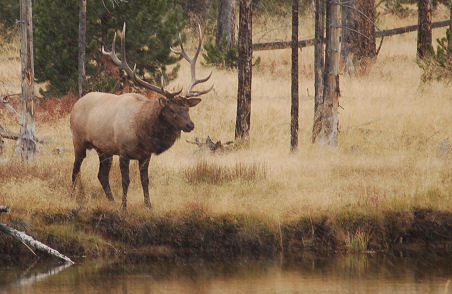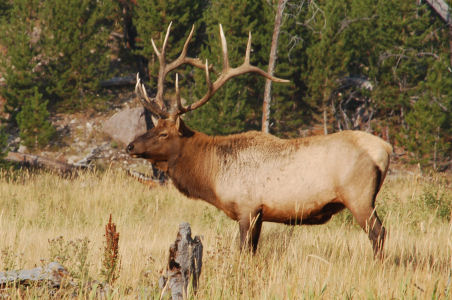Back to
Yellowstone N.P.
main page
WILDLIFE
Bears
Bison
Coyote
Elk
Mountain Lion
Pronghorn Antelope
Wolves
More Yellowstone N.P.
ACCOMMODATIONS
Inside the Park
Outside the Park
PARK FACILITIES
Canyon
Fishing Bridge
Grant
Madison
Mammoth
Norris
Old Faithful
Roosevelt
Tower
West Thumb
VISITOR INFORMATION
Related Web Sites
Visitor Centers
Communities near Yellowstone NP
Belgrade, MT
Bozeman, MT
Gardiner, MT
Livingston, MT
Red Lodge,
MT
Virginia City, MT
West Yellowstone, MT
Wyoming Travel Regions
Central
Grand Teton N.P.
Northeast
Northwest
Southeast
Southwest
Yellowstone N.P.
Yellowstone National Park Wildlife
Elk
The elk, or cervus elaphus, has frequented the Yellowstone area for more than 900 years. The most abundant of Yellowstone's large mammals, elk can be seen in just about every section of the park, although it is known to prefer the grassy, open areas that provide easy forage for large herds.

Although the males often travel by themselves, calves and cows can be seen in large numbers in the Gardiner and Mammoth areas and Lamar Valley. Studies also show that over the years, elk have also made use of the burned trees and foliage that were left following the 1988 Yellowstone fire. Elk have been seen in the Madison-Firehole area, where low elevations and new growth offer year-round opportunities for food.

Herd populations vary in Yellowstone according to season; as many as 30,000 elk make their home in the park during the summer. During the winter, elk either move out of the park or take up residence in the lower elevations, away from the sub-zero temperatures of Yellowstone's mountainous terrain.
The second largest member of the deer family (moose are the largest), adult elk can range in weight from 500 to 700 lbs. The coat is usually a reddish brown color and is accented by a distinctive rear patch and dark brown mane. The male is distinguished by his large, majestic antlers, which are a sign of strength and status. Antlers are shed in March and regrow in the spring, just before the fall "rutt" when males lock horns in competition for eligible females.
Go Northwest!
Bookstore
Best selection of books on the Northwest.
Click here!
 Compass
American Guides: Yellowstone & Grand Teton National Parks, 1st Edition
by Brian Kevin. Fodor's Compass American Guides have a new design and
practical information you need to make the most of your visit to
Yellowstone and Grand Teton National Parks. Easy-to-use practical
information you need to get around and experience the best of Yellowstone
and Grand Teton National Parks.
Order now...
Compass
American Guides: Yellowstone & Grand Teton National Parks, 1st Edition
by Brian Kevin. Fodor's Compass American Guides have a new design and
practical information you need to make the most of your visit to
Yellowstone and Grand Teton National Parks. Easy-to-use practical
information you need to get around and experience the best of Yellowstone
and Grand Teton National Parks.
Order now...
 The
Concise Visitor's Guide to Yellowstone by Matt Bolton. Sized perfectly
for backpacks this guide offers specifics on food, what to see, children's
activities, weather, wildlife, seasonal road closures, ranger programs,
visitor centers, what differentiates each section of the park and more.
Filled with information, phone numbers, web sites, and detailed maps this
is the tool to use when planning a trip to Yellowstone.
Order now...
The
Concise Visitor's Guide to Yellowstone by Matt Bolton. Sized perfectly
for backpacks this guide offers specifics on food, what to see, children's
activities, weather, wildlife, seasonal road closures, ranger programs,
visitor centers, what differentiates each section of the park and more.
Filled with information, phone numbers, web sites, and detailed maps this
is the tool to use when planning a trip to Yellowstone.
Order now...
 Moon
Spotlight Yellowstone National Park by Don Pitcher. 80-page compact
guide covering must-see attractions and maps with sightseeing highlights.
This lightweight guide is packed with recommendations on sights,
entertainment, shopping, recreations, accommodations, food, and
transportation, as well as easy-to-read maps.
Order now...
Moon
Spotlight Yellowstone National Park by Don Pitcher. 80-page compact
guide covering must-see attractions and maps with sightseeing highlights.
This lightweight guide is packed with recommendations on sights,
entertainment, shopping, recreations, accommodations, food, and
transportation, as well as easy-to-read maps.
Order now...
 National
Geographic Park Profiles: Yellowstone Country by Seymour L. Fishbein.
Yellowstone Country tours the stunning region that includes Yellowstone and
Grand Teton National Parks, a mosaic of national forests, wilderness areas,
wildlife refuges, countless waterfalls, hot springs and two-thirds of the
world's active geysers.
Order now...
National
Geographic Park Profiles: Yellowstone Country by Seymour L. Fishbein.
Yellowstone Country tours the stunning region that includes Yellowstone and
Grand Teton National Parks, a mosaic of national forests, wilderness areas,
wildlife refuges, countless waterfalls, hot springs and two-thirds of the
world's active geysers.
Order now...
We appreciate your orders. They help keep
Go Northwest! online.